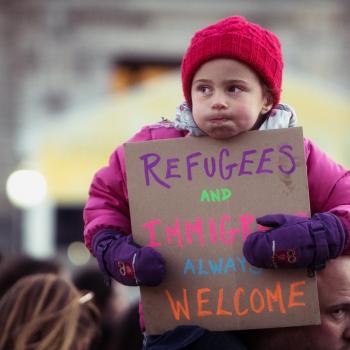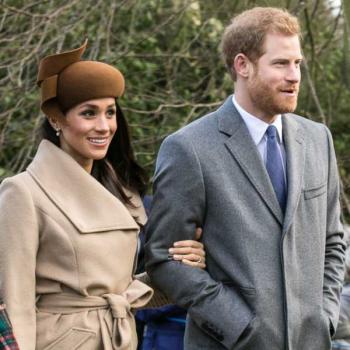For those who, like me, lament the tedious self-referentiality of contemporary haute couture, designer Anniesa Hasibuan’s array of flowing trousers, robes, and tunics, elaborately embroidered and elegantly layered, is a welcome alternative. Her line of clothing is inspired by Muslim fashion, particularly the traditional dress of Jakarta. And in her show, each outfit is worn with a hijab.
Cue cries of “Trojan horse in western civilization!” Among those who are concerned about protecting the traditions of white European and American culture Islamophobic, bringing the hijab to the fashion world is just another way Sharia Law insidiously creeps in, a clandestine jihad on the catwalk.
Well yes, Hasibuan and others are seeking to inscribe the hijab, and other elements of Muslim dress, within the accepted parameters of the everyday. As Melanie Elturk, CEO of Haute Hijab wrote:
“I believe fashion is one of the outlets in which we can start that cultural shift in today’s society to normalize hijab in America so as to break down stereotypes and demystify misconceptions.”
For those of us who are more worried about consumerism, nihilism, and violence than with cultural intermingling, breaking down stereotypes and demystifying misconceptions looks like a good idea. We need more communication, more sharing of ritual, and this means letting individuals speak for themselves about their cultural and religious practices. This also means respecting the boundaries set around those practices: as Catholics, for instance, sharing ritual does not mean that everyone is welcome to receive holy communion. When we don’t understand these boundaries, we may unwittingly commit violence. Cultural exchange can be tense, even volatile, for this reason, and we should question the viability of the melting-pot metaphor, since valuing traditions means not wanting them melted down and made indistinguishable. Clothing, and ritual function as communication, but we can’t understand what is being communicated in a ritual breaking of bread, or in the adornment of a body, without learning the language of that tradition.
But it is certainly the case that hijabs on the catwalk introduce us to a whole intriguing set of ironies:
- Many of the people fomenting against the normalization of the hijab, partially because they consider it demeaning to women and say women ought to be able to choose their clothing freely, are the same who object to revealing dress in women, who support the practice of female “veiling” in churches, and who think the movement for female equality is the source of all iniquity.
- “Normalization” is not typically what happens in the world of high fashion, however. If glamorous models adorned in stylized and expensive garments are all the rage in New York today, this does not mean that tomorrow ordinary hijabs will be considered normal in rural areas where prejudice against Muslims is common. If normalization of Muslim dress and custom is going to happen, to the extent that Muslims will no longer be exposed to prejudice and stereotyping, how are we going to get this trend to overflow from New York Fashion Week into small towns where people are still wearing the stonewashed jeans they bought in the 80s, without irony?
- Is normalization even a good thing? Do we want religious practice to become normal. Isn’t ritual a liminal zone where the normal and abnormal meet? How does religious practice interchange with fashion consciousness? This is something that should be especially interesting for Catholics to discuss, since the secular world loves adopting our bling for ornamentation, or for commentary (see Madonna and Lady Gaga).
- Still, unlike most things I see on the runway, this is clothing I would actually wear. If this clothing is designed to be a restraint on women by hegemonic patriarchy, why does it look so comfortable and mobile, compared to rigidly structured pieces and ankle-shattering hoof-heels? The funny thing about robes is that they are wonderfully androgynous, in both the shifting ambiguity of the lines and silhouettes, and in the historical tradition of who wears what. One can don a flowy tunic and enjoy it for what one perceives as a feminine flowing softness, but remember, this same set of lines can be used to designate wizardly mystery, hieratic authority, or even the caped superhero look.
- This is especially weird for me because Muslim fashion is considered by many to be dictated by patriarchal prescriptions on the female body, and I have spoken repeatedly against the false notion of modesty as covering female flesh lest men be tempted to sin. Yet modesty thus conceived – the covering of the body – is precisely how this is marketed, and the new “modesty movement” in fashion is becoming trendy. I am sick to death of Catholic websites devoted to telling us women to cover up. I still stubbornly wear a bikini, even on my post-partum body. I am sick of being told that modest is hottest, and being presented with images of “modesty porn” designed to present the female form in a way that allows men to objectify it and desire it without feeling sexually guilty. On the other hand, as I am no longer a 25-year-old size 2 with rock-hard abs and perky everything, it is nice to have the option to swathe myself in layers, to move about mysteriously. Covering flesh gives me a sense of authority I didn’t have in my maiden days. Am I more willing to accept this approach to clothing if presented to me with the enchantment of Otherness? Are the opponents of women’s liberation suspicious of modesty precisely because they are terrified of this same Otherness? Is Otherness even as real as we imagine it?
The big problematic backdrop to this is, no matter what the models are wearing, no matter how much I love it and applaud the artistry and goals of designers like Hasibuan and Elturk, it’s nearly impossible to pretend that sexism isn’t part of the world of high fashion. It’s an error to complain that ideology is creeping in here, into the hitherto innocent world of feminine fluff and flounces, because fashion has always been about ideology, and the ideology has almost always been sexist: whether covered or uncovered, the female flesh becomes the conquered territory on which masculine politics inscribes its boundaries and opens its territories for conquest. Of course, we’ve also used fashion to reclaim our bodies, to state out our territory as our own. But the different ways fashion communicates makes it difficult to tell, sometimes, who is empowered, and how.
During my brief time designing for an art couture project, one of my favorite pieces I made was a dress in classic Victorian style, imitating the layers and structure of a hoop skirt, but entirely in black transparent lace. The hoops became bars in a cage. The flesh, even of the leanest model, was visibly puckered and constrained by the repressive bodice: woman imprisoned in fashion, exposed behind bars. (I wish I had a photo I could share; the story of why I have no recordings of any of the work I did is all about the temperaments and passions of artists and their muses; one day I’ll put it in a novel).
And even if designers succeed in creating more images of female identity without recourse to narratives of subjugation or depersonalization, it is still the case that high fashion is driven by market forces, inextricable from global capitalism, which is itself inextricable from economic injustice, environmental exploitation, and the military industrial complex. How ironic that this gesture of demystifying for the sake of peace and community depends, for it to occur, on the hidden hinges of violence. The clothing is beautiful; tragedy is beautiful, too. The clothing is far more expensive than anything I will ever dream of wearing.
I’ve used the word “power” a few times, above. Fashion is empowering, but when we invoke power we need to ask: power over whom? There is aesthetic power, too, which is different from the political (Nietzsche got this, though most of his readers don’t). Whatever I may think of the problematic layering of intersectional concerns in the presentation of hijabs in high fashion, I cannot deny the aesthetic power of the look. This, for certain, we should see more of.
Take a look at the clothing, and see what you think.












